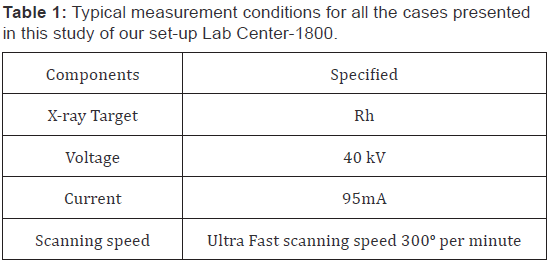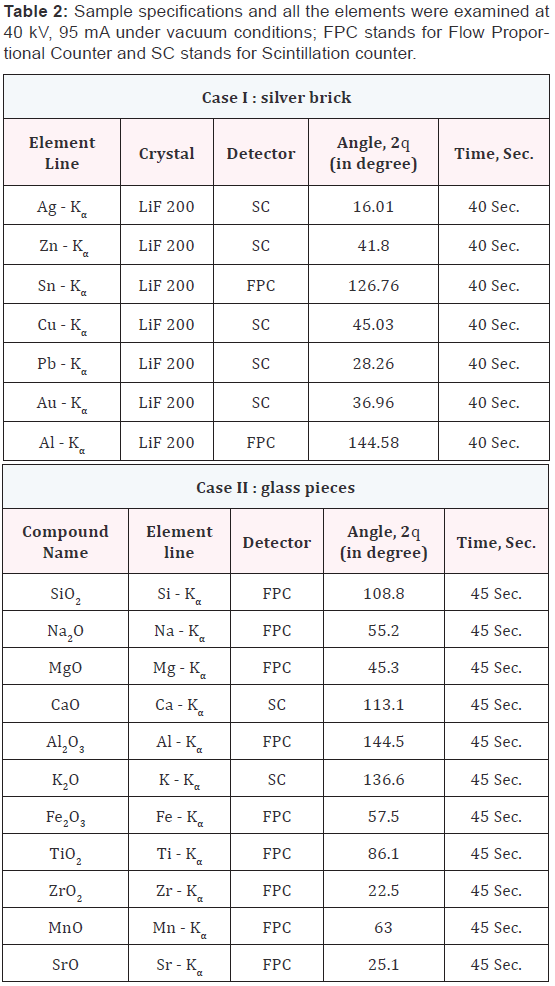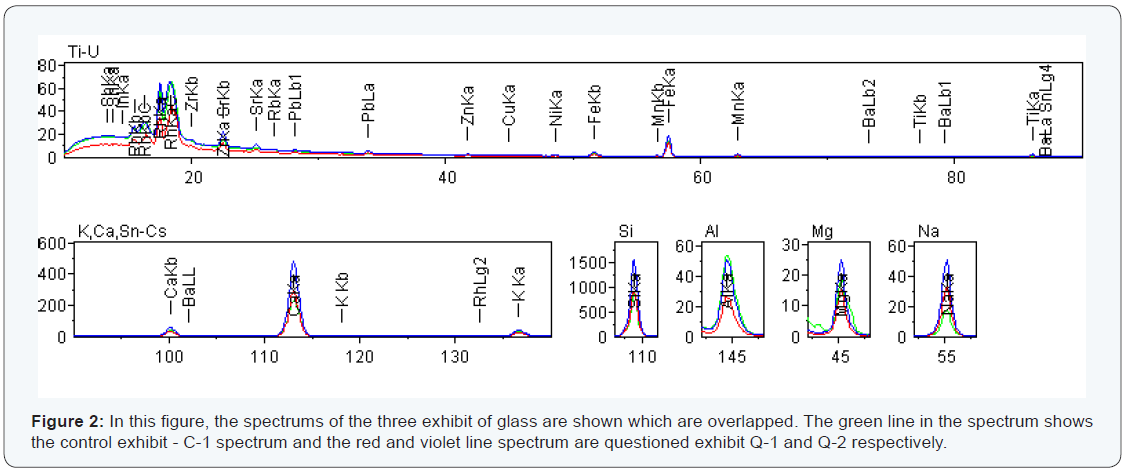X-Ray Fluorescence Analysis: Useful For Forensic Examination
Journal of Forensic Sciences & Criminal Investigation
Authored by: Mukesh Sharma
Introduction
Various kinds of forensic evidential samples have been controlled by criminal laws and could not be destroyed carelessly, even if any analytical examinations should be needed on the samples, while those samples should be examined rapidly on the basis of the human rights of the concerned suspects or victims. Those evidential samples have been observed and have been examined by many forensic experts [1]. Such samples have thus needed to be analyzed for elemental composition, in turn leads to the investigating agency to know the type and origin of the clue material to reach the criminal or victim. X-ray Fluorescence (XRF) spectroscopy is a non-destructive technique of analysis widely used in forensic science for the identification of elements in pigments, metal alloys, and other materials of evidential clues recovered from the scenes of crime [2,3].
In this paper, we have reported the application of XRF to examine the evidences like purity of gold and silver jewelry (Indian Ornaments) and remnants of glass pieces recovered from crime scenes. In this study, we have also intended to explore the advantages of the XRF method [4], the capabilities of simultaneous multi-element non-destructive, analysis and automatic handling of a large number of samples. XRF spectrometry is widely used technique for the analysis of metals, alloys, composite (glass) and polymers (paint-chip). This paper reports the quantitative and qualitative elemental analysis of silver brick and glass fragments using the WD XRF spectrometer and the FP method.
Case I: In this case, a jeweller was cheated by two people. Those had supplied him a fake silver brick having 15.4 cm x 13.2 cm x 3.9 cm dimensions, quoting that the brick is made of 80 to 85 % of silver. After purchasing this by an amount of 1.5 million Indian rupees, he doubted that the brick was fake and the persons, who had sold him the brick, were fraud. So, he lodged a complaint against them in police station. The brick was forwarded to the State Forensic Science Laboratory, Rajasthan (State FSL) for examination of its purity.
It is important to note, in Indian context, that a number of different techniques are used to fabricate jewellery which results in samples that vary considerably in homogeneity, and hence their suitability for accurate XRF analysis. Lost wax investment casting, extrusion - rolling - stamping, pressed powder, and electroforming processes are all used to design jewellery. Each of these methods results in jewellery samples that possess unique XRF measurement characteristics due in part to the macroscopic metallurgical properties of the alloy being used. One can study the phase diagram for the Ag – Cu system to understand that the Silver-rich fraction of higher melting point will solidify first that in some cases, creates a silver-rich ‘skin’ on the surface of the sample. In addition, a piece of jewellery may have areas of solder, electro-plating, or multiple coloured alloys juxtaposed with the parent alloy. Since XRF is essentially a surface analysis technique with an effective depth of approximately 10um for typical jewellery alloys, it is possible for ‘sample - prep’ errors to be introduced into the measurement due to heterogeneity [5].
Case II: In this case, an accident was happened between a car and truck. The police had sent many glass fragments collected from the scene of occurrence to the State FSL, Jaipur with control sample of the suspect vehicles. Preliminary identification of glass fragment was made using GRIM-2 (Glass Refractive Index Measurement) of Foster-Freeman, UK. The best match RI (Refractive Index) fragment were taken for XRF analysis, two of them were marked as Q-1 and Q-2 and one control sample marked as exhibit C-1. The investigating agency was interested to know whether the suspect’s vehicle had hit the victim’s vehicle causing death. Applications by XRF [6-8], total – reflection XRF [9,10], XRF and electron probe microanalysis (EPMA) [11,12], neutron activation analysis [13] and XRF with pyro-electric X-ray generator [14] on the analysis of glass and ceramics have been reported already available in the literature.
Experimental
The XRF analysis of the samples were performed with a Shimazdu sequential X-ray fluorescence spectrometer Lab Center XRF-1800 Wave-length dispersive XRF spectrometer [15] using the 10 mm to 20 mm sample aperture, the instrument condition are given in Table 1 and the case examined listed in Table 2 with dimensions and detection parameter. Samples were rotated at 300o per minute. An end window X-ray tube with a Rhodium target was used to generate X-rays.


Discussion
Case study I: In this case we have applied the chemical test of silver, observed that all surfaces having silver layer. So, it gave us misguiding results. Then the brick was cut from three different corners and all the three cut pieces have been marked as exhibits A/1, A/2 and A/3. In these three exhibits having two surfaces, Figure 1 demonstrated the cut exhibits. The inner and outer surfaces have further been marked as s-1 & s-2 surfaces, respectively. The results of examination of the three exhibits and their surfaces in the silver brick are summarised in the Table 3. From Table 3, it is clear that the brick has two different layers. The outer layer having purity about 70-75 % silver on the other hand in the inner layer the brick has about 70 -71 % cooper and the other elements like Zn, Pb, Al and Sn were in traces.
ADH = Time (hrs.) X (Average temp. – Minimum development threshold temperature).
Whole formulae for PMI calculation by using ADH method is depicted in Table 4. The PMI estimated was 9.6 days and her death may occur on 17th October 2014 (Table 4). The autopsy was performed 2 days after recovery of corpse. According to autopsy surgeon the PMI of corpse is 10 to 12 days without intimating any known reason of death. This case study illustrates the importance of using insect evidence to estimate minimum Postmortem Interval and to reconstruct a possible scenario of the events.




Discussion
Case study I: In this case we have applied the chemical test of silver, observed that all surfaces having silver layer. So, it gave us misguiding results. Then the brick was cut from three different corners and all the three cut pieces have been marked as exhibits A/1, A/2 and A/3. In these three exhibits having two surfaces, Figure 1 demonstrated the cut exhibits. The inner and outer surfaces have further been marked as s-1 & s-2 surfaces, respectively. The results of examination of the three exhibits and their surfaces in the silver brick are summarised in the Table 3. From Table 3, it is clear that the brick has two different layers. The outer layer having purity about 70-75 % silver on the other hand in the inner layer the brick has about 70 -71 % cooper and the other elements like Zn, Pb, Al and Sn were in traces.
Case II: Table 4, shows that the elements detected in each sample are same in both exhibits but their relative intensity and percentages are different. When the elements detected are same, two exhibits are similar or not with the control sample can easily be identified. The same elements (Si, Ca, Mg, Fe, Al and K) were detected in the questioned marked as Q-1, Q-2 and control sample as C-1, where the relative peak intensity is differ in all. But question exhibit Q-1 and control exhibit C-1 are almost having same intensity as shown in Figure 2. The results of the three exhibits are summarised in the Table 4.
Results
In the present paper the quantitative analysis of sample, made it possible to estimate the approximate concentrations of elements by a simple quantification. This kind of highly sensitive spectrometer [15] is useful for rapid identification elements possible in the field of forensic science.
Case I: Table 3 shows that the element detected in inner and outer surfaces of the exhibits are different from each other. Even the detected elements are different, the sample can be compared for identified, i.e. whether the two surfaces are same or not can be concluded. The same element (Ag, Zn, Sn, Pb, Al and Cu) were detected in the outer surface and inner surface, where the relative peak intensity of inner and outer surfaces were different from each other. From the Table 3, it is clearly seen that the after 3 mm depth from the outer surface the brick having no silver. The elements in the inner surfaces are mainly Cu, Zn, Pb and Sn in traces has been observed.
Case II: In this case one can easily demonstrate that the XRF can be very useful to investigate the elemental composition in glass fragments. The accuracy of the elemental analysis of these glass pieces by XRF has been assessed by comparison with the control samples. The result with SiO2 and Na2O are in agreement within 1.1 % in control sample C-1 and questioned sample Q-1. Furthermore, CaO, Al2O3, K2O, Fe2O3, TiO2, ZrO2, MnO and SrO all agree within 0.10 percent. It is clear that from these results that the elemental analysis of these glass fragments determined by this XRF technique is in excellent agreement between the questioned Q-1 and control C-1.
Conclusion
In case I it was found that the brick cleverly designed by a person who is expert in moulding and the skill was used in cheating. XRF revealed that the silver brick was a fake one. Case II was a case of hit and run on a highway by the analysis of the glass fragments it was established the suspect’s vehicle hit the victim’s vehicle.
Summary
X-ray fluorescence is a useful and versatile analytical technique in any laboratory, let alone a forensic science lab. The purpose of this research paper is to raise the awareness of XRF, in a forensic context, be almost as important as the analysis itself. The prevention of evidence, contact trace evidence, may be vital, so non-destructive method analysis is essential. One can conclude that the XRF analysis is a useful and non-destructive tool for measuring the elemental composition of metals, glass and ceramics.
Acknowledgement
The authors are thankful to the Director, FSL, Jaipur, Rajasthan (India) for his support and help at every step. The work is partly presented in International Conference INTERNATIONAL CONFERENCE & EXHIBTION ON NEUTRON & X-RAY SCATTERING, Malaysia in 2009.p>
To know more about please click here: juniper publishers Linkedin

Comments
Post a Comment